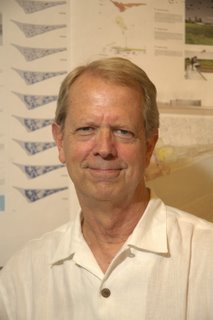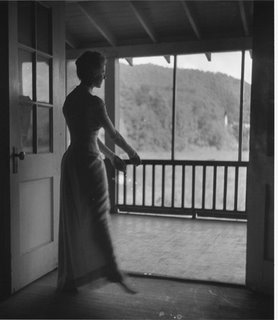Frank Harmon: Bauhaus Meets the Farm House

Architecture is the triumph of human imagination over materials, methods, and men, to put man into possession of his own earth.
Frank Lloyd Wright, 1930.
Architecture is certainly the most unforgiving of the arts. A painting which we’ve grown tired of we can sell or put away until it pleasures our eyes again; a dance persists but for the moment of its actual movement, and there’s no way to revisit the actual event, whatever media we might have brought to bear on it. Good or ill, it’s gone, ephemeral as dawn. But the artworks of the architect are the very spaces in which we live, labor, and play. If they’re unlivable, well … As Frank Lloyd Wright said, “The physician can bury his mistakes, but the architect can only advise his clients to plant vines.” (New York Times Magazine, 4 Oct. 1953) Vines, unfortunately, won’t do much for poorly designed interior space. There, the remedies are more radical – and far more dear.
True confession: way back in the 1960s, when I was a teenager trying to decide what to do with my life, I seriously considered becoming an architect. It seems like a curious consideration, looking back; there were no buildings in Charlotte that I knew of that excited me with their redefinition of structural dynamics. I had encountered, though, the work of Frank Lloyd Wright through his writings on the “natural house” and through photographs of his structures in the books I sought out about the man. I think I recognized in him, however little I knew about the field in which he worked, a great auteur, a creative original. Part of my psyche has been fascinated by architecture ever since. When I went to Buffalo, New York, in 1968, one of the city’s several attractions was that it was home to Black Mountain College poet Robert Creeley, but another was that it was also the location of several of Wright’s prairie-phase homes. The State University of New York, in fact, had just the year before acquired the Darwin D. Martin House Complex, built between 1903 and 1905; the University used it as its president’s residence. The president often opened it for receptions and parties, so several times I had the pleasure of visiting and exploring, between glasses of wine and conversations about the topics of the day, that magnificent old building, which still contained, if memory serves, some pieces of the original furniture that Wright had designed for it.
That active interest in architecture had been dormant for some years, as creative energies found other channels, but the new Thinking Ahead exhibit at the Black Mountain College Museum + Arts Center has certainly roused it again. The show offers tantalizing glimpses of the work of a few of the modernist architects associated with the college, men who worked in the same era as Wright to reshape our experience of lived space, and create a new architecture, one freed from classical traditions. On the 26th of this month, Raleigh architect Frank Harmon, FAIA, whose firm was selected by Residential Architect Magazine as the 2005-2006 Residential Architect Firm of the Year, journeys to Asheville to speak on the subsequent development of Modernism in our own era, in the south of farmhouses and traditional vernacular structures. It’s a subject he should know well, since his own work clearly takes the Modernist project as its initial premise.
Given that Harmon’s firm has been selected to develop the new UNCA Crafts Campus north of town along the French Broad River, his presentation should spark significant interest in our fair mountain city.
I’ve not yet set foot in a Harmon building, but his firm’s website offers an extensive collection of photographs of his projects through the years, both small projects (there’s even a dog house, or dog box, as the site qualifies it) and large – as in the very attractive 70,000 square foot renovation and addition to the NC Farm Bureau in Raleigh. It’s an impressive body of work, a unique blend of Modernist aesthetic and vernacular values. It manifests decent respect, even affection, for the materials of structure (especially wood, often exposed to great effect). The Farm Bureau project, with its emphasis on open space and its artful use of interior columns, reminded me (given that Frank Lloyd Wright’s work is still an important point of reference for me), for all the apparent difference of scale, of Wright's office projects, such as the Johnson Wax building in Racine, Wisconsin, with its graceful columns and cantilevered ceiling. Asheville architect Jim Samsel was impressed by another Harmon project, the Iron Studio at Penland School, and says it's a good example of the way Harmon integrates
function with structure. It has great a connection to outdoors via views & daylight, as well as very appropriate and well detailed materials for the given use.
His work at Penland and elsewhere conveys a thoughtful integration of the building's purpose and clear, expressive structure. It portrays a contemporary language that's in harmony with the local architectural vernacular of the South. His buildings appear always carefully sited and respectful of the natural environment.
Samsel has high expectations for the new Crafts Campus:
I expect [it] to convey many of these same principles, and to be inspiring to all who appreciate design excellence, as well.
Harmon seems to be able to make even compact buildings feel open and expansive, and yet his work (as revealed at least in the photographs) can convey also a sense of shelter, something sometimes hard to come by in a typical Modernist structure. It’s that rare combination of qualities, the tension between the vernacular and modern, that led a juror in the AIA North Carolina competition in 1999 (when Harmon won three out of the four Honor awards for which he was entered) to remark, “I don't who this guy is, but he's either a genius or a schizophrenic.”
In an interview for a recent article in Residential Architect, Harmon attributes his approach to his mentor of many years, Harwell Harris. “What people thought was cold and threatening modernism, he made warm and approachable,” Harmon says. “Harwell was a big influence on me in this way: he taught me that every client and every situation is different and new. And it is the architect's job to understand the needs of every situation and every client. He loved to say that the house is a portrait of the client. He was a very important person to me – still is.”
Harmon seems to have mastered that art of portraiture, and to be able, as Wright had it, to put his clients in possession of their own earths. I doubt that he’s had to advise many of his clients to plant vines.
What: Frank Harmon, The Bauhaus + The Farmhouse: Reflections on the Modern Movement in the South. There will be a reception and silent auction to benefit BMCM+AC. Co-sponsored by AIA Asheville and the UNCA Office of Cultural and Special Events.
When: Thursday, October 26th, 7:30 PM
Labels: arts, BMCMAC, Buffalo, Frank Harmon, Frank Lloyd Wright







